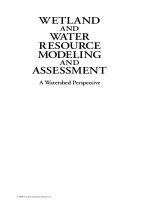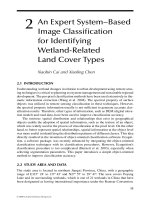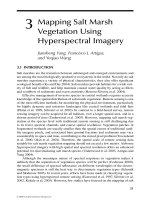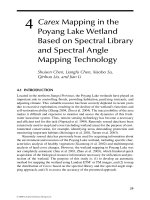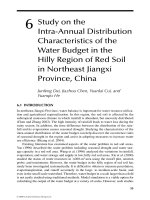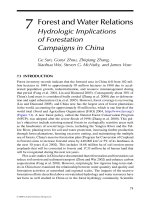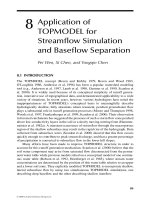WETLAND AND WATER RESOURCE MODELING AND ASSESSMENT: A Watershed Perspective - Chapter 4 pot
Bạn đang xem bản rút gọn của tài liệu. Xem và tải ngay bản đầy đủ của tài liệu tại đây (1.07 MB, 12 trang )
29
4
Carex Mappinginthe
Poyang Lake Wetland
BasedonSpectralLibrary
and Spectral Angle
Mapping Technology
Shuisen Chen, Liangfu Chen, Xiaobo Su,
Qinhuo Liu, and Jian Li
4.1 INTRODUCTION
Located in the northern Jiangxi Province, the Poyang Lake wetlands have played an
important role in controlling oods, providing habitation, purifying toxicants, and
adjusting climate. This valuable resource has been severely depleted in recent years
due to excessive exploitation, resulting in the decline of the wetland’s functions and
self-restoration ability (Zhang 2004, Zhu et al. 2004). The inaccessibility of the area
makes it difcult and expensive to monitor and assess the dynamics of this fresh-
water lacustrine system. Thus, remote sensing technology has become a necessary
and efcient tool for this task (Nepstad et al. 1999). Remotely sensed data have been
extensively used to map land cover (including wetland areas) for the purpose of envi-
ronmental conservation, for example, identifying areas demanding protection and
monitoring important habitats (Steininger et al. 2001, Turner et al. 2003).
Remotely sensed data has previously been used for acquiring information about
the environment and resources of the Poyang Lake wetland, including specic char-
acteristics analysis of healthy vegetation (Xiaonong et al. 2002) and multitemporal
analysis of land cover changes. However, the wetland mapping in Poyang Lake was
not completely automatic (Jian et al 2001, Zhao et al. 2003), which hindered quick
acquisition of the biological resource information necessary for utilization and pro-
tection of the wetland. The purpose of this study is: (1) to develop an automatic
method for mapping the wetland using Landsat ETM
+
or TM images, and (2) to map
the distribution of Carex based on the spectral library and the spectral angle map-
ping approach, and (3) to assess the accuracy of the presented approach.
© 2008 by Taylor & Francis Group, LLC
30 Wetland and Water Resource Modeling and Assessment
4.2 DATA AND METHODS
4.2.1 D
ATA
Two Landsat images, TM (July 15, 1989, ood season), and ETM+ (December 10,
1999, dry season), were used in this study. The rst was used for automatic mapping
of the ooding area and the second for the extraction of beach vegetation information
within the Poyang Lake cofferdam. Before subsetting images, radiometric calibration
was performed to transform the digital number (DN) values into image reectance.
4.2.2 FLOODING AREA EXTRACTION
The ood season image was used to create a mask of two primary classes—water
and land. The ood plain extent of Poyang Lake during the ood period was used
for the automatic mapping of the lake beach vegetation distribution area in the low
water season, limiting the Carex mapping area within the lake beach wetland and
water area. The identied ood plain area from the July image was used as a mask
to obtain the lake beach wetland and water area from the December image, that is,
our study area. From Figures 4.1 and 4.3, it is obvious that the water body and land
have different reectance values. This allows the setting of a threshold to distinguish
the water body from the land using reectance values. As a comparison, in previous
research (Niu and Zhao 2004), only the DN values of Landsat imagery were used,
which reduced the precision of wetland vegetation mapping using spectral informa-
tion. Based on the statistical analysis of reectance of the water body and land region
on Band 4 (Figures 4.2 and 4.4), a threshold value of 0.12 was applied to distinguish
water and nonwater areas on the image of July 15, 1989, because Band 4 (near-infra-
red band) provided the best differentiation between water and land. Image pixels
with a reectance value less than 0.12 were classied as a water body (including both
lake and reservoir waters), and the rest as land. It can be seen from Figure 4.4 that the
reectance of lake water is smaller than 0.12.
FIGURE 4.1 Location of reference reservoir transect in the lake area.
© 2008 by Taylor & Francis Group, LLC
Carex Mapping in the Poyang Lake Wetland 31
0.25
0.20
0.15
0.10
0.05
10
Location of Transect across Reservoir
20 30 40 50 60
Reflectance
TM4
TM3
TM2
10
Location of Transect across Reservoir
20 30 40 50 60
0.25
0.05
0.10
0.15
0.20
Reflectance
TM4
TM3
TM2
FIGURE 4.2 Reectance transect of ETM
+
Band 4 across a reservoir.
FIGURE 4.3 Location of the lake water reference transect in the lake area.
© 2008 by Taylor & Francis Group, LLC
32 Wetland and Water Resource Modeling and Assessment
4.2.3 SPECTRAL ANGLE MAPPING (SAM)
One of the most commonly used methods in spectrometry is the comparison of spec-
tral angles among different land covers. Figure 4.5 illustrates the difference in spec-
tral angles among natural materials (lake water, reservoir water, land) spectra and
the lake water endmembers, with the analysis results in Table 4.1. Traditionally, the
spectral distance and probability-based classication methods do not consider the
linear scaling of overall reectance patterns. Spectral angle mapping techniques, on
0.25
0.20
0.15
0.10
0.05
Reflectance
TM2
TM3
TM4
50 100 150 200 250
Location
FIGURE 4.4 Reectance transect of ETM
+
band 4 across Poyang Lake.
25
Frequency
20
15
10
5
0
0.105 0.155 0.205 0.255 0.305 0.354
Reflectance of Land Near Lake Water Boundary
2500
Frequency
2000
1500
1000
500
300
Frequency
250
200
150
100
50
0
0.00 0.01 0.02
Reflectance of Lake Water
0.03
0.020 0.022 0.024 0.026 0.028 0.030
Reflectance of Reservoir Water
AB
C
FIGURE 4.5 Spectral angles of lake water endmembers, lake water, reservoir, and land.
© 2008 by Taylor & Francis Group, LLC
Carex Mapping in the Poyang Lake Wetland 33
the other hand, incorporate linearly scaled reectance patterns to avoid the misclas-
sication of land use and land covers, which are the linearly scaled versions of a
particular reectance pattern.
The angle that denes a spectral signature or class does not change, and the vectors
forming the angle from the origin delineate and contain all possible positions for the
spectra (Sohn and Rebello 2002). These parameters encompass all the possible combi-
nations of illumination for the spectra. Changes in reectance due to the effect of illu-
mination are still within the class angle (Sohn et al. 1999). The fact that the spectra of
the same type are approximately linearly scaled versions of one another due to illumi-
nation and topographic variations is utilized to achieve accurate classication results
(Sohn et al. 1999). Because the spectral angle classier utilizes the shape of the pattern
for the clustering and classication of multispectral image data (Sohn and Rebello
2002, Luo and Chen 2002, An et al. 2005), the analyst’s ability to relate eld informa-
tion to spectral characteristics and spectral shape patterns for different land cover and
land use types is an important factor for achieving accurate mapping results.
In this study, spectral angle–based statistical analysis could better quantify
Carex vegetation than other wetland types. It is more convenient and useful than
traditional supervised and unsupervised methods of classication.
4.3 RESULTS AND DISCUSSION
The comparison of reectance range and frequency between different land covers
helps to distinguish various water bodies from land in the study area (Figure 4.5).
Table 4.1 further explains the reective difference between water bodies and land.
The multispectral composite image of water bodies in the study area indicates that
the extent of light-colored water represents more turbid lake water (Figure 4.6);
Figure 4.7 depicts the spatial distribution of the reection for different water bodies.
Figure 4.8 is a vector map of water body distribution within the boundary of 14 lake-
shore towns in Poyang Lake wetland area. Figures 4.8 and 4.9 show the distribution
of dense Carex based on the spectral angles of image pixels with reference to the
Carex endmember. The total area of Carex is 166 km
2
. According to the formula for
calculating landscape fragmentation index:
C = ∑Ni/A
TABLE 4.1
Various ranges of different water and nonwater bodies in reflection.
Sample land cover Minimum Maximum Scope of most pixels
Lake water 0.015 0.0355 100%
Reservoir water 0.0267 0.296 100%
Nonwater body 0.1045 0.3650 0.1403–0.3650
(98.7%)
0.1245–0.3650
(99.6%)
© 2008 by Taylor & Francis Group, LLC
34 Wetland and Water Resource Modeling and Assessment
where C is the landscape fragmentation index of Carex, ∑Ni stands for the total number
of Carex landscape type polygons, and A is the total area of the Carex landscape.
The fragmentation index of the Carex landscape in the Poyang Lake wetland area is
0.6041 (0 represents landscape that has not been depleted, and 1 represents landscape
that has been completely destroyed), which is higher than the Honghu Lake wet-
land, the other important wetland in China, with a landscape fragmentation index of
0.4207 (Wang et al. 2005). This gure indicates that the landscape in Poyang Lake is
inuenced by human activities more severely than that of the Honghu Lake wetland.
The area of Poyang Lake’s water body within the boundary of 14 lakeshore towns
Water Body
N
S
EW
FIGURE 4.6 Multispectral component image of extracted water body in study area (R, G,
B = TM 4, 3, 2). (See color insert after p. 162.)
© 2008 by Taylor & Francis Group, LLC
Carex Mapping in the Poyang Lake Wetland 35
in Figures 4.6 through 4.8 is 4,209 km
2
while the central lake water area is 3,340
km
2
(Figure 4.10). The precision of the dense Carex mapping was validated by the
eld of investigation (Figure 4.11). According to the 11 eld sites, there were 10 sites
that had growth in dense Carex, with the remaining site having growth of Arte misia
selengensis. However, there was Carex growing under the Arte misia selengensis. A
high precision of 91% for Carex mapping was achieved.
FIGURE 4.7 Water bodies of different reection in the study area. (See color insert after
p. 162.)
© 2008 by Taylor & Francis Group, LLC
36 Wetland and Water Resource Modeling and Assessment
4.4 CONCLUSION
The automatic and quick mapping method for discriminating land and water, and
different turbidities of water, has proved to be an effective tool for wetland monitor-
ing. Specically, it was possible to accurately detect the dense Carex by the spectral
angle mapping approach based on the comparison of the reection of Carex end-
members and the image pixels. The method used to extract the ood plain could also
be used to automap the other wetland types. This study shows that multitemporal
images with their near-infrared reection of water bodies and spectral library, are
valid choices for automatic and quick wetland classication.
EW
N
S
Water Body
FIGURE 4.8 Vector map of Poyang Lake wetland.
© 2008 by Taylor & Francis Group, LLC
Carex Mapping in the Poyang Lake Wetland 37
FIGURE 4.9 Distribution of dense Carex in Poyang Lake. (See color insert after p. 162.)
ACKNOWLEDGMENTS
This research was supported by the open fund of the Key Lab of Poyang Lake Eco-
logical Environment and Resource Development of the Chinese Ministry of Educa-
tion housed in Jiangxi Normal University, China’s 863 High-Tech Research Plan
Project (No: 2002AA130010), and the 2005 Science and Technology Plan Fund of
Jiangxi Province. Thanks also to two anonymous reviewers for their helpful com-
ments and suggestions.
© 2008 by Taylor & Francis Group, LLC
38 Wetland and Water Resource Modeling and Assessment
EW
N
S
Dense Carex
FIGURE 4.10 Vector map of Carex distribution focused on the central Poyang Lake wet-
land area.
© 2008 by Taylor & Francis Group, LLC
Carex Mapping in the Poyang Lake Wetland 39
FIGURE 4.11 Sites of eld investigation in the study area. (See color insert after p. 162.)
REFERENCES
An, Bin, Shu-hai Chen, and Wei-dong Yan. 2005. Application of SAM algorithm in multi-
spectral image classication [in Chinese]. Chinese Journal of Stereology and Image
Analysis 11(11):55–61.
Jian, Yongxing, Rendong Li, Jianbo Wang, and Jiakuan Chen. 2001. Acta Phytoecologica,
Sinica 25(5):581–587.
Lan, Tianwei. 2004. Poyang Lake wetland is formally applied to be protected as world’s natu-
ral heritage. />Luo, Yu-xia, and Huan-wei Chen. 2002. Comparing degree classication with distance clas-
sication—with salt soil as an example [in Chinese]. Remote Sensing for Land and
Resources 2:46–48.
© 2008 by Taylor & Francis Group, LLC
40 Wetland and Water Resource Modeling and Assessment
Nepstad, D. C., A. Verissimo, A. Alencar, C. Nobre, E. Lima, P. Lefebvre, P. Schlesinger,
C. Potter, P. Moutinho, E. Mendoza, M. Cochrane, and V. Brooks. 1999. Large-scale
impoverishment of Amazonian forests by logging and re. Nature 398:505–508.
Niu, Ming-xiang, and Geng-xing Zhao. 2004. Study on remote sensing techniques on wet-
land information extracting in Nansihu area. Territory and Natural Resources Study
4:51–53.
Sohn, Y., E. Moran, and F. Gurri. 1999. Deforestation in north-central Yucatan (1985–1995):
Mapping secondary succession of forest and agricultural land use in Sotuta using
the cosine of the angle concept. Photogrammetric Engineering and Remote Sensing
65(8):947–958.
Steininger, M. K., C. J. Tucker, J. R. G. Townshend, T. J. Killeen, A. Desch, V. Bell, and P.
Ersts. 2001. Tropical deforestation in the Bolivian Amazon. Environmental Conserva-
tion 28:127–134.
Turner, W., S. Spector, N. Gardiner, M. Fladeland, E. Sterling, and M. K. Steininger. 2003.
Remote sensing and biodiversity science and conservation. Trends in Ecology and Evo-
lution 18:306–314.
Wang, Xi, Xianyou Ren, and Fei Xiao. 2005. Remote sensing and GIS-based landscape structure
analysis of Honghu Lake wetland, www.sdinfo.net.cn/xinxizhuanti/2005/xxzt-78.html.
Wessels, K. J., R. S. De Fries, J. Dempewolf, L. O. Anderson, A. J. Hansen, S. L. Powell,
and E. F. Moran. 2004. Mapping regional land cover with MODIS data for biological
conservation: Examples from the Greater Yellowstone Ecosystem, USA and Pará State,
Brazil.
Remote Sensing of Environment 92(1):67–83.
Xiaonong, Zhou, Lin Dandan, Yang Huiming, Chen Honggen, Sun Leping, Yang Guojing,
Hong Qingbiao, Leslie Brown, and J. B. Malone. 2002. Use of Landsat TM satellite
surveillance data to measure the impact of the 1998 ood on snail intermediate host
dispersal in the lower Yangtze River Basin. Acta Tropica 82(2):199–205.
Youngsinn, Sohn, and N. Sanjay Rebello. 2002. Supervised and unsupervised spectral angle
classiers. Photogrammetric Engineering and Remote Sensing 68(12):1271–1280.
Zhao, Xiaomin, Mengxian Yuan, and Hu Wang. 2003. Study on remote sensing investigation
and comprehensive utilization of low-grassland in Poyang Lake Region. Acta Agricul-
turae Universitatis Jiangxiensis 25(1):84–87.
Zhang, Juntao. 2004. Elementary accounting of resources and environment loss in Poyang
Lake wetland [in Chinese]. Statistical Research 8:9–12.
Zhu, Lin, Yingwei Zhao, and Liming Liu. 2004. Protective utilization and function estimate
of wetlands ecosystem in Poyang Lake [in Chinese]. Journal of Soil and Water Con-
servation 18(2):196–170.
© 2008 by Taylor & Francis Group, LLC


